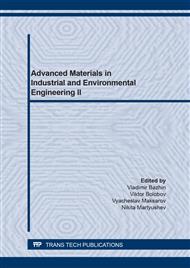[1]
A. Hanif, P. Parthasarathy, Z. Lu, M. Sun, Z. Li, Fiber - reinforced cementitious composites incorporating glass cenospheres - mechanical properties and microstructure, Construction and Building Materials 154 (2017) 529–538.
DOI: 10.1016/j.conbuildmat.2017.07.235
Google Scholar
[2]
R. Polat, R. Demirbog, W.H. Khushefati, Effects of nano and micro size of CaO and MgO, nano-clay and expanded perlite aggregate on the autogenous shrinkage of mortar, Construction and Building Materials 81 (2015) 268–275.
DOI: 10.1016/j.conbuildmat.2015.02.032
Google Scholar
[3]
K. Liu, Z. Shui, T. Sun, G. Ling, X. Li, S. Cheng, Effects of combined expansive agents and supplementary cementitious materials on the mechanical properties, shrinkage and chloride penetration of self-compacting concrete, Construction and Building Materials 211 (2019)120-129.
DOI: 10.1016/j.conbuildmat.2019.03.143
Google Scholar
[4]
Z. Xiong, Y. Zeng, L.G. Li, A.K.H. Kwan, S.H. He, Experimental study on the effects of glass fibres and expansive agent on the bond behaviour of glass/basalt FRP bars in seawater sea-sand concrete, Construction and Building Materials 274 (2021) 122100.
DOI: 10.1016/j.conbuildmat.2020.122100
Google Scholar
[5]
M.A.A. Sherir, M.A. Khandaker, K.M.A. Hossain, M. Lachemi, Self-healing and expansion characteristics of cementitious composites with high volume fly ash and MgO-type expansive agent, Construction and Building Materials 172 (2016) 80–92.
DOI: 10.1016/j.conbuildmat.2016.09.125
Google Scholar
[6]
V. Nelyubova, N. Pavlenko, D. Netsvet, Cellular composites with ambient and autoclaved type of hardening with application of nanostructured binder, IOP Conference Series: Materials Science and Engineering 96(1) (2015) 012010.
DOI: 10.1088/1757-899x/96/1/012010
Google Scholar
[7]
V. Corinaldesi, A. Nardinocchi, Mechanical characterization of engineered cement-based composites prepared with hybrid fibres and expansive agent, Composites Part B: Engineering. 98 (2016) 389–396.
DOI: 10.1016/j.compositesb.2016.05.051
Google Scholar
[8]
R. Moradpour, E. Taheri-Nassaj, T. Parhizkar, M. Ghodsian, The effects of nanoscale expansive agents on the mechanical properties of non-shrink cement-based composites: The influence of nano-MgO addition, Composites Part B: Engineering 55 (2013) 193–202.
DOI: 10.1016/j.compositesb.2013.06.033
Google Scholar
[9]
S.P. Shah, P. Ho, M.S. Konsta-Gdoutos, Nano-modification of cementitious material: toward a stronger and durable concrete, Journal of Sustainable Cement-Based Materials (2015) 1–22.
DOI: 10.1080/21650373.2015.1086286
Google Scholar
[10]
A. Nazari, S. Riahi, S.F. Shamekhi, A. Khademno, Assessment of the effects of the cement paste composite in presence TiO2 nanoparticles, Journal of American Science 6 (2010) 43–46.
Google Scholar
[11]
G. Jing, Z. Ye, J. Wu, S. Wang, X. Cheng, V. Strokova, V. Nelyubova, Introducing reduced graphene oxide to enhance the thermal properties of cement composites, Cement and Concrete Composites 109 (2020) 103559.
DOI: 10.1016/j.cemconcomp.2020.103559
Google Scholar
[12]
Y.E. Begich, S.V. Klyuev, V.A. Jos, A.V. Cherkashin, Fine-grained concrete with various types of fibers, Magazine of Civil Engineering 97(5) (2020) 9702.
Google Scholar
[13]
L. Chaurasia, V. Bisht, L.P. Singh, A novel approach of biomineralization for improving micro and macro-properties of concrete, Construction and Building Materials 195 (2018) 340-351.
DOI: 10.1016/j.conbuildmat.2018.11.031
Google Scholar
[14]
E. Tsangouri, A decade of research on self-healing concrete, Sustainable Construction and Building Materials (2018) 21–36.
DOI: 10.5772/intechopen.82525
Google Scholar
[15]
V.V. Strokova, U.N. Dukhanina, D.A. Balitsky, Crack closure in a cement matrix using bacterial precipitation of calcium carbonate, Lecture Notes in Civil Engineering 95 (2021) 158-164.
DOI: 10.1007/978-3-030-54652-6_24
Google Scholar
[16]
U.N. Dukhanina, V.V. Nelyubova, O.I. Drozdov, D.A. Balitsky, Assessment of the Fungus Resistance of Cement Stone with a Biocide with Bacterial Cultures Used in Carbonate Biomineralization, Lecture Notes in Civil Engineering 147 (2021) 154-160.
DOI: 10.1007/978-3-030-68984-1_23
Google Scholar


